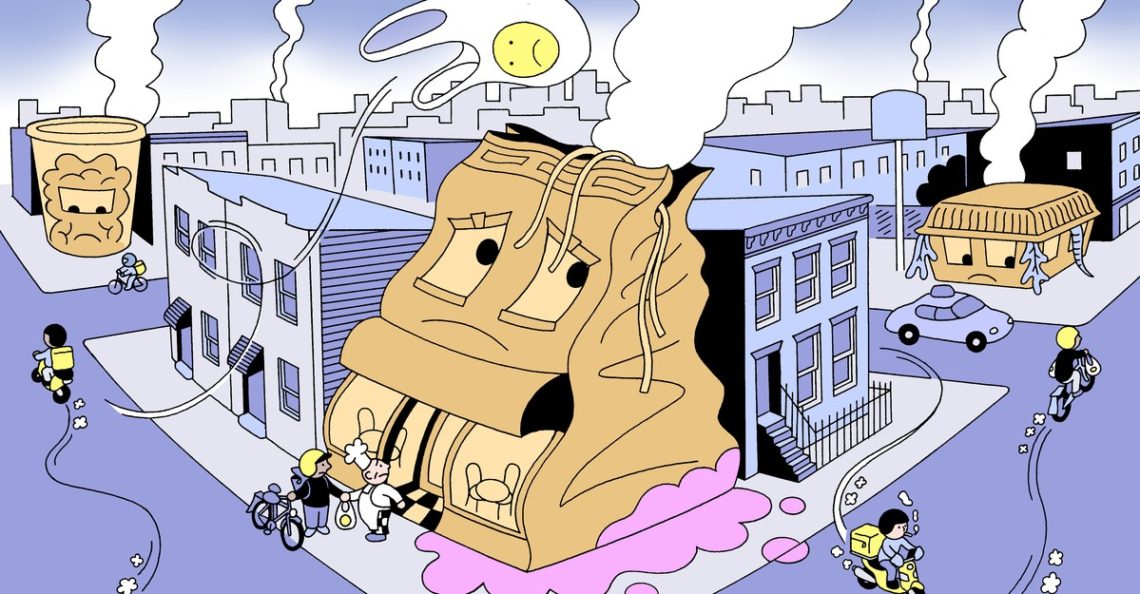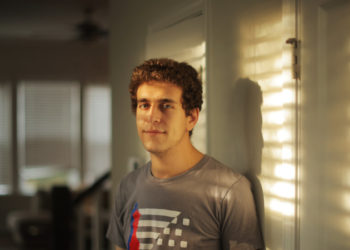Colin Wallace wanted a snack. Specifically, he wanted one delivered to his classroom during lecture (he had long lectures). This was 2006, when delivery was mostly limited to a few types of food, and it was something you did by talking on the phone and then waiting awhile. Wallace was in engineering school at Georgia Tech, and he figured his problem was one the internet could help solve. He built a way for customers to order online, automatically syncing to food vendors’ systems. That project became a company, and that company was eventually acquired, in 2011, by Grubhub. Wallace was experimenting, making stuff with his friends, and then he was in leadership at a company that would go on to help change restaurants forever.
Because today, of course, you can get not just a snack but almost anything you want sent to you just about wherever you are. You can have an ice-cream sundae, a martini, or an expertly seared Wagyu steak delivered to your door, without pausing the TV or finding your shoes. You can have coq au vin from an “extra-charming, French-inspired gastrothèque” long beloved for its perfectly styled shoebox of a space, and you can have it miles away from the very space that makes the restaurant so special. Whatever you order, it will come from a business that operates a bit differently than it once did: less like a restaurant and more like a pickup counter, the product on offer less like “an experience,” as the restaurateur Tom Colicchio told me earlier this year, and more like “a commodity.” It will, in all likelihood, be packed into paper and so much plastic, bundled up like a baby in a snowstorm, doing its best to survive a trip it isn’t entirely equipped to make. And it will probably be ferried by a precariously employed person who is financially incentivized to move quickly, not safely, and who has one of the more dangerous jobs in America. An entire commercial mechanism will have whirred to life the moment you clicked “Place order,” one that is part of an industry that barely existed 15 years ago but now brings in tens of billions of dollars in revenue annually.
In 2024, nearly three out of every four restaurant orders were not eaten in a restaurant, according to data provided to me by the National Restaurant Association, a trade group. The share of customers using delivery specifically, as opposed to picking up takeout or going to a drive-through, more than doubled from 2019 to 2024. In a recently released poll by the association, 41 percent of respondents said that delivery was “an essential part of their lifestyle.” For Millennials and Generation Z—the apex consumers of today, and of tomorrow too—it’s apparently even more essential: More than half of adults under 45 use delivery at least once a week, and 13 percent use it once a day. Five percent use it multiple times a day. But the delivery boom isn’t confined to young people or to urbanites: About one in eight Baby Boomers uses delivery once a week, and so does about one in five rural dwellers. We are a nation of order-inners. A world, really—earlier this year, DoorDash announced a deal to acquire the British delivery service Deliveroo for $3.86 billion; the new, combined company will have 50 million monthly active users, spread over more than 40 countries.
For as long as fast-food and pizza joints have existed, certain restaurants have been defined by, and designed for, takeout and delivery. But delivery has now come for what industry analysts call “full-service restaurants”—that is, the types of places where a server guides you through your meal from start to finish, or at least used to. These days, 30 percent of those restaurants’ orders are consumed somewhere else, according to the National Restaurant Association. The fanciest, most famous restaurants are still doing mostly table service, but just about every other establishment has been conscripted into the army that ferries hot food out of professional kitchens and into American mouths 24 hours a day, 365 days a year. Meanwhile, the longtime industry analyst Joseph Pawlak told me, “you could shoot a cannon” through many dining rooms on a Tuesday night.
In effect, delivery has reversed the flow of eaters to food, and remade a shared experience into a much more individual one. If communities used to clench like a fist around their restaurants, now they look more like an open palm, fingers stretched out as far as possible, or at least to the edge of the delivery radius.
The history of delivery is long, but the important stuff happened in the 2000s. Around then, a new kind of company started popping up—Seamless in 1999, Grubhub in 2004, Postmates in 2011, Caviar in 2012, DoorDash in 2013, Uber’s delivery subservice in 2014. These businesses presented a modern solution to a modern problem. Nobody wanted to talk on the telephone anymore, but chefs and restaurant managers didn’t exactly know how to build their own websites and payment portals. Many restaurants already outsourced their human resources or legal or design to third parties; outsourcing delivery just seemed efficient. Soon enough, and without entirely realizing it, restaurants had turned a core part of their business operations over to technology companies. They wouldn’t get it back.
Tech companies tend to operate very differently from pizza joints. For one thing, they are typically obligated, by the venture-capital firms that fund them, to grow as quickly as possible. In this case, that meant that the delivery companies needed to ensnare people who had never made delivery a part of their life before. So throughout much of the 2010s, these companies followed what’s now a familiar formula: They attracted new customers by offering lots and lots of discounts, using all of that venture capital to subsidize the actual cost of doing business. Customers got inexpensive delivery, restaurants could make decent money from it, and Silicon Valley covered the difference. The logic was that whichever company won the delivery wars would have access to a potential consumer base of everyone who eats. The effect was that some of the most well-capitalized companies on Earth invented a product that did not previously exist, and then invented the consumer expectation that it came cheap.
Then, the coronavirus pandemic. Eating restaurant food at home went from an indulgence to an occasional necessity to something virtuous, a sort of 21st-century victory garden. (“Think of all the places you want to survive and start ordering,” the food publication Eater advised.) All sorts of restaurants—many of which were carrying significant debt due to pandemic closures, and many of which had never considered delivery in the past—started offering it. They couldn’t afford not to. “You have to find revenue wherever you can find it,” Colicchio, who runs five restaurants in three cities, told me. From April 2019 to April 2020, the major delivery apps’ sales more than doubled.
Convenience is like sex: Once you’ve had it, it’s hard to forget how good it is to have it. As soon as Americans understood that it was possible to have any food they wanted whenever they wanted, they came to expect it. Once dining rooms reopened, many people didn’t return. Even if you didn’t order delivery yourself, you could probably see the transformation happening: The corps of gig workers moving around cities in a sort of technologically aided dinner ballet; the drivers rushing into restaurants, phones aloft; the jokes online about delivery as a lifestyle; the plastic bags on people’s doorsteps, latter-day lawn gnomes. Like so many tech innovations of its era, app-enabled delivery facilitated the easy trading of money for time, and introduced new categories of consumption. Like so many miracles, it became mundane surprisingly quickly.
The fact that diners love ordering in so much gives the huge companies that facilitate it tremendous power. “These delivery companies are basically saying, You have to use us, and there’s value in it,” Colicchio told me. “And if you don’t use us, you’re not gonna be in business.”
Delivery is essentially a weapon that restaurants can wield against their competition—and when your competition has a weapon, you need one too. “And so,” Wallace, the lecture snacker, told me, “what you get is this zero-sum game where you’re basically just selling weapons to both sides, but no one’s actually better off, because it turns out there’s only so much stomach space to go around.”
But delivery companies have a problem too: Delivery is an inherently difficult proposition, financially speaking. Compared with eating in a restaurant (or even ordering delivery from a restaurant directly), involving a third party fundamentally requires the use of more labor, more infrastructure, more overhead. Somebody has to pay for it. Eventually, after years of venture-capital-funded subsidies, delivery companies had to find ways to pass all of these costs on to someone else—and they did, as the industry consolidated. DoorDash bought Caviar in 2019; Uber bought Postmates the year after. (Those two companies now control about 90 percent of the U.S. market combined. Grubhub, which was bought in 2024 by the food-hall chain Wonder, owns 8 percent.) And then, Wallace explained, “it just became extractive.” Customers are getting charged more; drivers are making less. One South Carolina DoorDash driver told me he recently chauffeured a single serving of ice cream five miles; he was paid $3.50 before taxes for about 20 minutes’ work, and estimates that the customer paid about $15 for it.
But mostly, restaurants are losing out. Delivery companies charge at least 5 percent commission and often much more, up to 30 percent. They typically charge for payment processing, for in-app advertising, and for favorable placement in search results. They charge for pickup orders. And the restaurants are thrashing. That’s the word Wallace used: “It’s like not swimming or treading water,” he said—“it’s just thrashing to survive. You spend more and more on the platforms trying to advertise, but it doesn’t fundamentally help other than subsidizing the platforms.” (A Grubhub spokesperson told me in a statement that restaurants use the platform because it helps them reach new customers, and that restaurants are “in control every step of the way, and only pay when an order is placed.”)
In a sense, what restaurants did during the early pandemic was take out a loan they didn’t know they wouldn’t be able to pay off. They were borrowing customers and got the immediate infusion of cash they needed, but at a rate that was excruciatingly high. Shannon Orr runs an eight-restaurant group on the West Coast. Recently, she opened her books to me, by way of illustration. In 2024, one of her restaurants made about half of its sales on delivery, for $1.7 million in gross receipts. Of that, $400,000—or 23 percent—went to delivery companies. “That’s somebody’s job, by the way, which is why I just laid off people,” she told me. “That’s two salaries.” The restaurant was previously one of her most profitable, but last year, she told me, it didn’t make any money. “Delivery saved us during the pandemic,” she said. “Now they are killing us.”
Orr’s restaurants are neighborhoody: the kinds of places a family might go for a birthday, or a couple might go for a relaxed weeknight date. About 10 years ago, a few years after Wallace started at Grubhub, I lived around the corner from one of them, a pub called Ben ’N Nick’s, in Oakland, California. It had wood paneling, a pitiless bar-trivia host, and perfect wings. I haven’t been in years, but from what Orr told me, it’s different now. Foot traffic is down; delivery is up. Because she has fewer customers sitting down for a meal, she’s shifted some of her waiters to a counter, turning people trained to serve into glorified cashiers. Sometimes she looks around her restaurants and doesn’t believe how empty they feel. She has been in hospitality for two decades, and doesn’t know what hospitality is anymore. “I’m a restaurateur,” she told me. “And now I don’t want to open a huge restaurant. I want to open a bar with five tables and a huge takeout window.”
Pawlak, the restaurant analyst, told me he hasn’t seen a wave of restaurants closing directly as a result of delivery. But he also told me that in three decades, he’s never seen a change quite like this. About a third of full-service restaurants have modified their space over the past few years to account for the delivery boom, according to data from the National Restaurant Association. Applebee’s recently opened a Long Island, New York, restaurant outfitted with a handful of tables and a big bank of lockers, “designed,” per a press release, “to maximize the speed of service for delivery.”
Soon, Pawlak predicted, we’re likely to see smaller restaurants with bigger kitchens, expressly designed to cook food not being eaten on-site. Interior-design firms are touting their ability to build restaurants around delivery, with bike parking, clear signage, dedicated entrances, wallfuls of cubbies to shove bags into—essentially trying to cram two experiences into a building that used to house one. (If you’re eating dinner, the restaurant designer Lauren Chipman told me, “and you’re getting jostled by third-party delivery and their big bags, and maybe people are queuing behind your seat and they’re talking really loud or standing over you eating, that would not be an optimal dining experience, right?”) At the most extreme end, many new restaurants opening in big cities aren’t meant for in-person dining at all—they are ghost kitchens, purpose-built for delivery: dinner factories.
The food itself is changing too. Some restaurants are trying to save on labor costs by turning toward less intensive dishes—this is part of the reason everything is a bowl now. Many have reworked their menus to account for the simple physical fact that anything warm put into a container immediately begins to steam in its own heat, getting soggy. “It does not taste as good as it did when the restaurant put it into the box,” the writer and restaurant expert Hillary Dixler Canavan told me—it can’t. Chefs told me they’re doing fewer fried items, more braises, more dressings on the side. Everyone is trying to account for the subversion of a dynamic that has defined restaurants since they were invented: that the person cooking the food largely got to decide how it was consumed. “At a great restaurant,” Canavan said, “the flow and timing of how food and drinks arrive at your table is a major part of enhancing that experience.” Now there is no experience, and restaurants cede control as soon as the bag leaves.
Canavan is concerned—for restaurants, on a financial level, and for the food itself. “If a high percentage of any given restaurant’s sales is happening in delivery, that will inevitably shape menus to be more delivery friendly,” she told me. “What does that mean for culinary innovation and experimentation and creativity?”
It’s a great question, and it gets at the fundamental shift taking place before our eyes and under our feet. A restaurant that doesn’t serve people isn’t really a restaurant—it’s something else. “We opened up restaurants so you would come to them, not so we could go to you,” Phillip Foss told me. “Otherwise, we’re just a catering company.”
Foss is the chef and owner of EL Ideas, a Michelin-starred restaurant in Chicago. During the early pandemic, Foss, like so many of his peers, started doing delivery. Eventually, however, he had to stop; the math just didn’t work out. “My feeling at the time, especially during the pandemic, was, you know—this can destroy this entire restaurant industry, if we’re giving this much of our gross income to the services,” he said. At Foss’s restaurant, the prix fixe is $245, and the menu is over-the-top theatrical (for years, he served a course of dehydrated-coconut-and-lime powder, expressly designed to look like cocaine). His food is intended to be enjoyed in person, and after pandemic restrictions were lifted, enough people wanted to that he didn’t need delivery.
These days, what’s left on Uber Eats and DoorDash are the restaurants that can’t afford to do that. Those are the places laying off staff and rejiggering their menus. Some are passing the cost on to eaters, tacking a few extra dollars onto the price of dishes when ordered for delivery—but as the economy hurtles toward a possible recession, $31 for spaghetti in a cardboard box starts to seem like a bad idea too. In what sure felt like an omen to me, earlier this year, DoorDash announced a partnership with the payment-by-installment company Klarna, thereby allowing customers to pay off an order of pad thai over several months.
I love restaurants. They feel very real to me. They operate in physical space and linear time. They are made of things you can see and touch and smell and taste. They have people in them. They surprise me. Part of what makes them feel special is the feeling of being taken care of—all this work made visible, even if it is also elegant and subtle.
Tech companies are kind of the opposite. They’re abstract. They are very good at hiding the effort, and the people, involved. The product that delivery companies offer isn’t food or even hospitality; it’s convenience you don’t need to think too much about. It’s all externality—costs, to the environment and the community and the labor force, atomized into the air in such a fine mist that you can barely see it.
Wallace wishes people saw it. “I don’t know if people realize or recognize the consequences of this,” he said of delivery’s wide adoption. “I don’t know if they actually understand what they’re paying when they place a delivery order. Whether it’s infrastructure, whether it’s the restaurants or the character of their local neighborhood or just the sheer dollars. I don’t think they necessarily know.”
After a year as Grubhub’s head of innovation, Wallace left the company. It was a gradual decision, he told me: Something that had felt normal stopped feeling good to him. He became familiar with the costs of running a restaurant, and also with the people who do it. He found himself in meetings about raising Grubhub’s fees, and he felt certain that the restaurants wouldn’t be able to absorb them. He used the term collateral damage—to the restaurant industry and to those who make it run: “The idea of standing on those people in order to get yourself to the next rung—it just leaves a sour taste in my mouth.” He doesn’t regret everything, but he regrets not paying closer attention.
“I was just having fun with my friends,” Wallace told me. “I think when I realized what the impact of what I was doing was, it actually hurt me, like, a lot. Like, I was pretty disappointed in myself.” He rarely orders delivery.
The post How Delivery Destroyed American Restaurants appeared first on The Atlantic.




